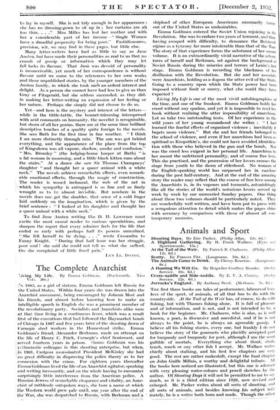The Complete Anarchist
Living My Life. By Emma Goldman. ( D uckworth Two • Vo13. 36s.)
;IN 1885, as a girl of sixteen, Emma Goldman left Russia for the United States. Within four years she was drawn into the Anarchist movement, being encouraged by Johann Most and his friends, and almost before knowing how to make an intelligible speech in English she was a prominent member of the revolutionary party. Socialists and Anarchists alike were at that time living in a continuous fever, which was a result first of the executions that had followed the Haymarket bOnrib of Chicago, in 1887 and five years later of the shooting down of t'arnegie steel workers in the Homestead strike. Emma Goldman's friend; Alexander Berkman, 'made an attempt on the life of Henry C. Frick, Carnegie's chief lieutenant, and served fourteen years in prison. Emma Goldman was his nthusiastic colleague in this shooting enterprise, but when, in 1901, Czolgosz assassinated President McKinley she had iro great difficulty in disproving the police theory as to her
-connexion with the crime. For eighteen years thereafter Emma Goldman lived the life of an Anarchist agitator, speaking and writing incessantly, and on the whole having to encounter surprisingly little interference from the American police. A Russian Jewess of remarkable eloquence and vitality, an Anar- chist of ruthlessly outspoken Ways, she boie a name at whieb.
the Western world grew pale until, one year after the end .of the War, she was despatched to :Russia, with Berkman and:a shipload of other European Americans summarily turn out of the United States as undesirables.
kmma Goldman entered the Soviet Union rejoicing in thi Revolution. She was to endure two years of torment, and then having escaped with difficulty, to denounce the Bolshevil regime as a tyranny far more intolerable than that of the Tsar The story of that experience forms the substance of her second ^ volume. It is an extraordinarily vivid narrative of the adven. tures of herself and Berkman, set against the background of Soviet Russia during the miseries and terrors of Lenin's last stage. Emma Goldman is recording the blackness of her disillusion with the Revolution. But she and her associate -were Anarchists, holding as a dogma the utter evil of the State. Going to a country upon which the State power had been imposed without limit or Mercy,' what else could they have expected ?
Living My Life is one of the most vivid autobiographies of the time, and one of the frankest Emma Goldman holds her creed without any qualms, and yet it is impossible to read her book without realizing the utter impossibility of anarchism. Let us take two -outstanding tests. Of her experience in the
wild years of her young womanhood she writes " I had • learned the fearful effects of organized violence ; inevitably it
begets more violence." But she and her friends belonged to the school of violence; and even if her anarchism had been as spiritual as Kropotkin's, she could not have avoided identifica- tion with those who believed in the gun and the bomb. Nor was the creed less exigent in her personal life. Anarchism to her meant the unfettered personality, and of course free love. This she practised, and the proCession of her lovers crosses the stage from youth to the dawn of elderhood. No woman of the English-speaking world has surpassed her in candour during the past half-century. And at the end of the amazing story the reader may reflect that the course of free love among the Anarchists is, in its vapours and torments,. astonishingly -like all the stories of the world's notorious lovers served up week by week by our unwearied Sunday papers.. One thing about these two volumes should be particularly noted. They are wonderfully well written, and have been put to press with a scrupulous attention to detail Which makes the pages shine with accuracy by comparison with those of almost all con. temporary memoirs.










































 Previous page
Previous page